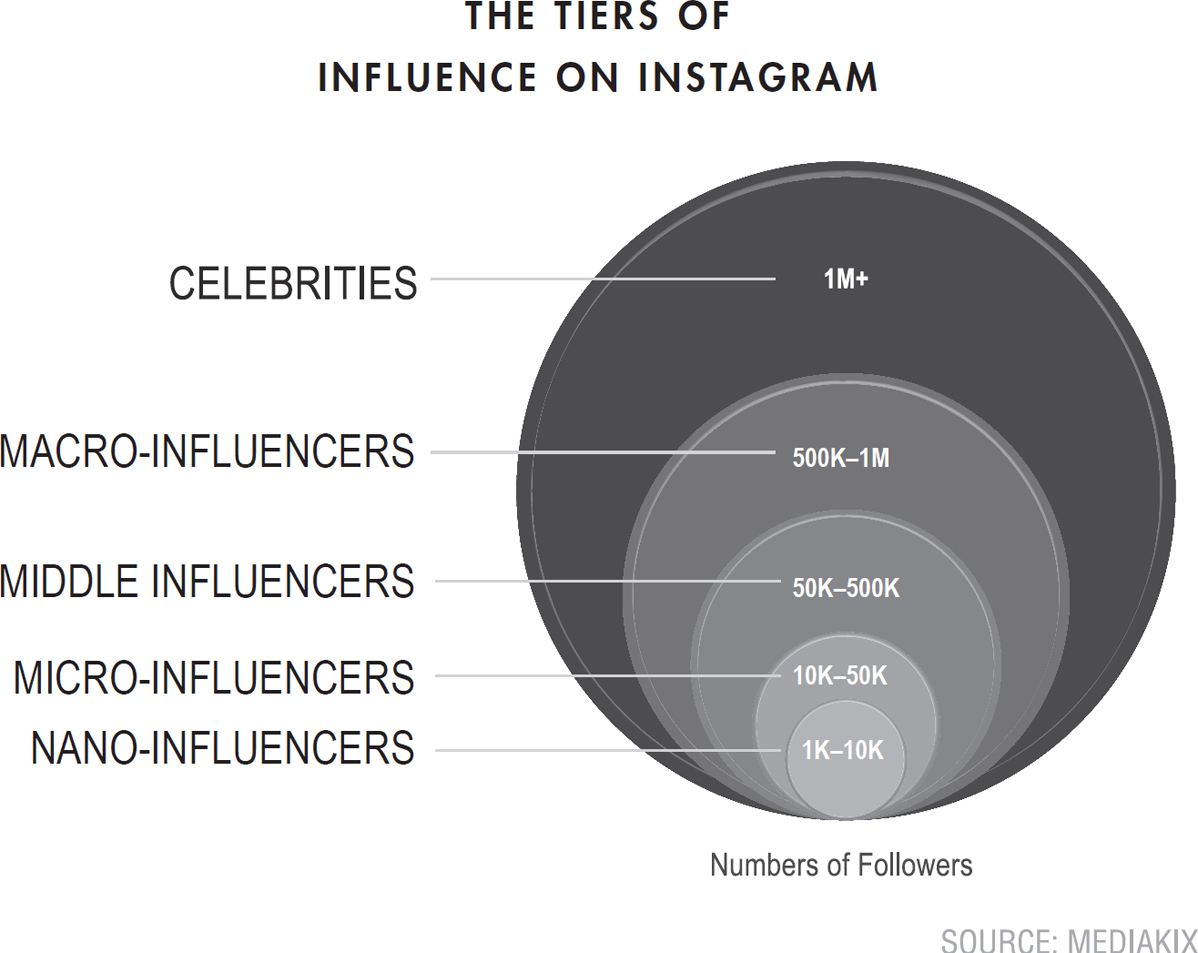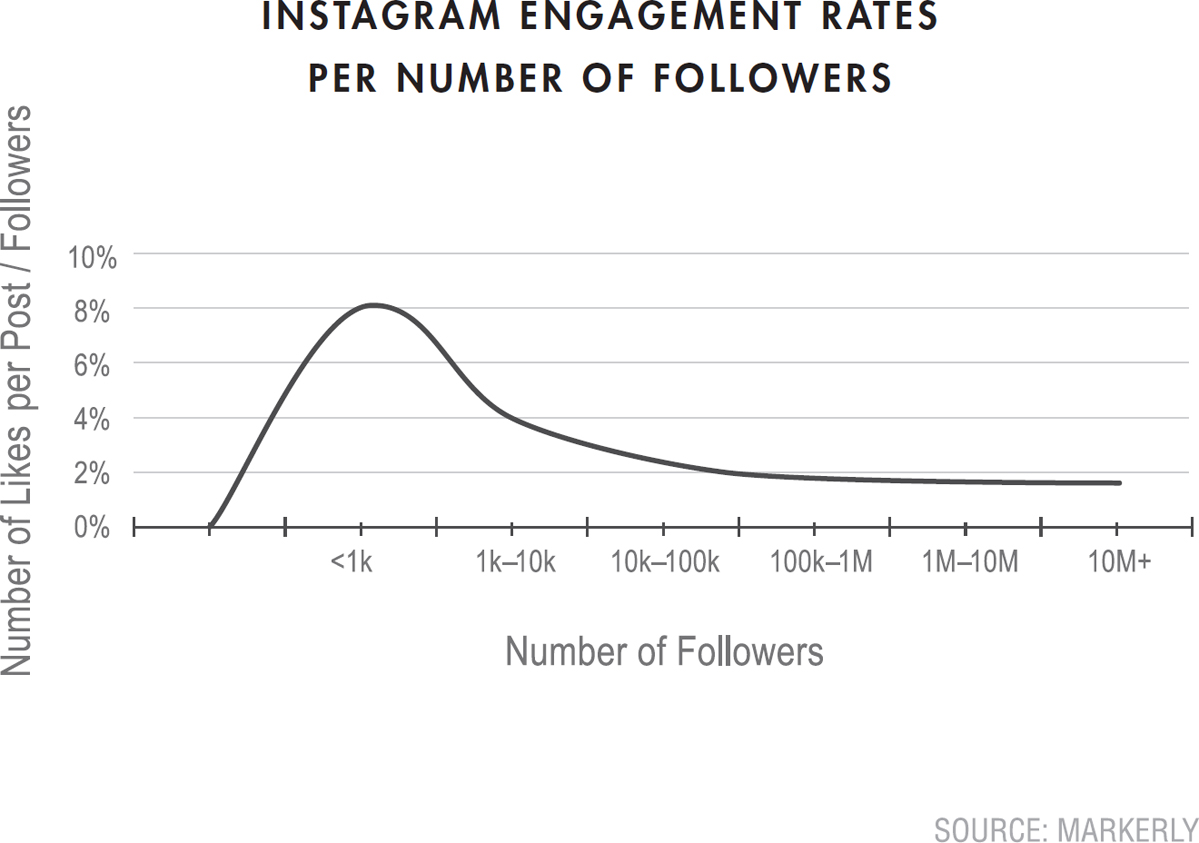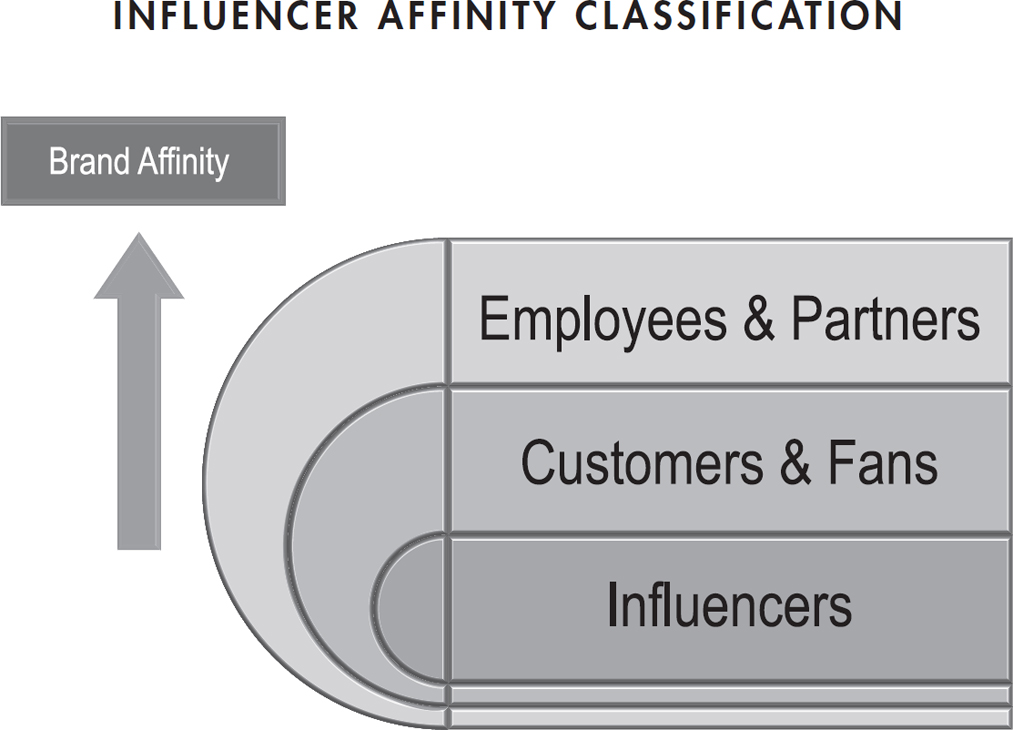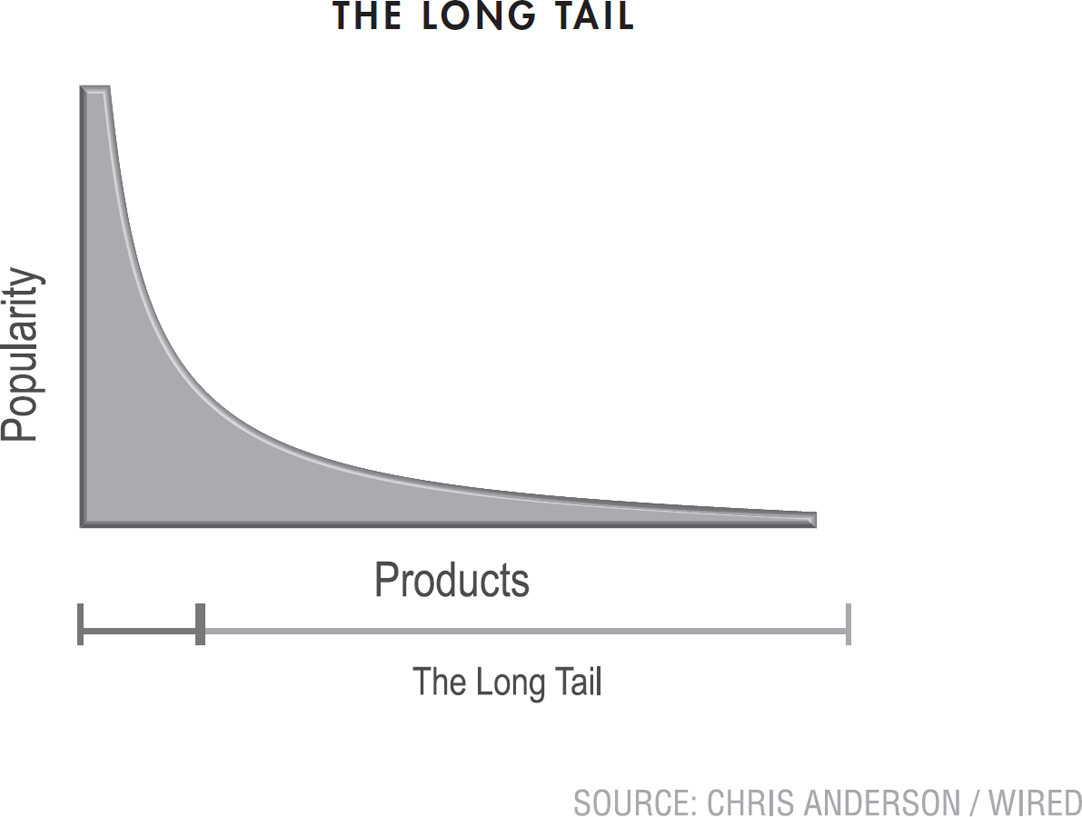UNDERSTANDING THE INFLUENCER LANDSCAPE
The Different Types and Levels of Influencers
The definition of an influencer is as broad as the definition of influence. By taking a look at the different types and levels of influencers, you will begin to better picture those influencers who will best fit your company’s plans.
When we talk about the kinds of influencers we can work with and how they fit with the entire social media landscape, we have to remember why influencers exist in the first place. People make decisions based on advice from people they trust. Increasingly, though, we are influenced by people we don’t know personally but have gotten to know through social media.
Beyond this, people want to hear from trusted voices with authority. Traditionally speaking, the trusted sources were businesses and the media. There were—and still are—entire departments within companies responsible for media relations, ensuring brand messages were released to the appropriate people. Brands had spokespeople to make statements to people with influence who would then broadcast the message to their viewers, listeners, or readers. This is essentially pre-social media content sharing through the “clips” of press releases.
The core reason companies and brands wanted these voices remains the same in the social media world: People trust people.
Influencers influence because they produce content that is heard, listened to, and trusted. Whether it’s a TV show or a financial market column, a blog post or a YouTube channel, this is trusted content. Anyone can be a publisher these days, and anyone can be an influencer, including family and friends, peers and practitioners. Whether it’s Yelp reviews, blogs, podcasts, photos, social conversations, tweets, LinkedIn posts, YouTube videos, or an Instagram image, everyone is producing content for an audience that’s spending more time on social media.
INFLUENCER AUDIENCE CLASSIFICATION
Let’s start by separating influencers into manageable classifications. I will look at two ways of approaching this. The size of a given influencer’s followers or community is one approach. We can classify influencers into five groups based on size of audience (see Figure 6.1). Note that the number of followers is only an estimated way of segmenting users, not an exact science, but these are tiers commonly used when filtering influencers on Instagram.
The Celebrity category is made up of the largest audiences, the social media accounts with over a million followers. Many of these are public figures already. They have developed their audience and built their own online brand. It’s important to remember that public figures or celebrities are not always influencers when it comes to social media. Someone who has a high visibility but doesn’t translate to a social media presence is not an influencer. Unless they shift their audience to a social media setting, their place as a trusted voice doesn’t translate within the realm of social media. Singers and musicians such as Beyoncé, Selena Gomez, and Taylor Swift are all prominent on Instagram. Others like Bono from U2 or Coldplay front man Chris Martin are certainly comparable celebrities but haven’t transferred their audience into an equally influential social media presence. Although Coldplay has an Instagram account, Chris Martin doesn’t engage personally.

Figure 6.1
Retired Los Angeles Lakers’ star Kobe Bryant is an example of an athlete who achieved celebrity status. After initially not engaging on social media and actually stating that he didn’t see the point, Bryant now has a following in the millions on Instagram. Bryant built his online brand. He is famously ambitious and aspirational and perhaps this swayed his thinking about social media engagement. Following his retirement, Bryant has continued to engage his social media audience as he builds his own brands in sportswear and entertainment.
A new generation of nontraditional celebrity influencers have emerged who have leveraged social media to become equally influential. These are people older generations might not know but younger generations do. This includes people like the YouTuber Logan Paul, with more than 10 million YouTube subscribers, and Kayla Itsines, “the most influential fitness star in the world” with more than 10 million Instagram followers.1 Daniel Middleton, the British YouTuber who is also the world’s highest paid YouTube star, began by creating Minecraft reviews.2 These are all celebrities within the realm of social media: They could not have become influencers without social media.
Macro-influencers are the next largest group, with follower counts numbering from half a million to a million. They influence on a large scale and might elevate into becoming a celebrity of their own over time. Macro-influencers have a large enough audience size to guarantee a significant amount of engagement for any brand that works with them.
Middle influencers comprises the group with audiences ranging from fifty thousand to half a million. At this level of influence, the influencer is beginning to charge more for posts and engagement. They often know the power of their community and are actively building it. Until recently, this level of influence had often been the lowest that many companies would approach. This view is understandable but overlooks the potential of engagement with smaller communities.
Micro-influencers are those with ten thousand to fifty thousand followers who are increasingly popular to work with because of the authenticity and “nicheness” of their communities. The sheer numbers of micro-influencers online make them an increasingly popular entity to engage with. One report stated that a total of 84 percent of sponsored posts on Instagram came from this demographic.3 Some platforms that work with connecting influencers with brands will only work with those whose audiences number over ten thousand. For this reason, many see this as the lowest level of influencer, discounting any audience lower than this.
Nano-influencers, those with an audience of one thousand to ten thousand, are often overlooked but are gaining in popularity for the same reasons micro-influencers are. I certainly think they have their place and should be recognized, especially in niche industries. Despite their small audiences, they are often well-connected and better able to communicate on a personal level with their communities. As we know, followers can be bought, and the numbers can be manipulated. Working with a nano-influencer who has a strong level of engagement is likely to give better returns than an influencer with ten thousand followers but a weak community.
HISMILE
MANY START-UPS NOW ENGAGE DIRECTLY WITH their target demographic through social media, opting to bypass traditional advertising as a first step. How can influencers help you break into your market? Can using only influencers help you grow in the traditional business sense?
HiSmile was started by two friends on the Gold Coast of Australia, intent on creating an easy-to-use teeth-whitening product.4 From the beginning, HiSmile saw the strength in engaging with influencers. Their first step was making sure they had a product they were confident in and able to present to influencers. They approached influencers and gifted products hoping for mention in social feeds. They focused heavily on smaller and micro-influencers with a strong following in certain regions. After months of experimenting, HiSmile found millennial women were their biggest market. They adjusted their program to reflect this.
The influencer program grew and after several years, Hi-Smile’s pool of influencers numbered over two thousand. Through experimentation, the brand learned that Instagram was the best performing social media network but still spent time tapping into other networks. Facebook presents a large share of the HiSmile influencer campaign, followed by YouTube and Twitter. Snapchat didn’t provide the results that HiSmile was looking for and so they scaled back their efforts there, though still kept a presence.
HiSmile reposts and shares their influencers’ content and continues to engage in their conversations. The constant commenting keeps a fresh and personal approach to the brand’s own account and continues the engagement with influencers beyond the product posts. They also engage with potential clients, answering questions and reposting results from their teeth-whitening products. The HiSmile feed also includes a great deal of comedy targeted at the fashion-conscious millennial audience.
After several years of positive results, HiSmile decided to invest in influencer marketing on a larger scale. They approached celebrities including Kylie Jenner and Conor McGregor. Of course, engaging with a celebrity influencer involved an investment beyond product gifting. Working with McGregor was a strategic move to connect with the male millennial market, with the hope of recreating their success with female millennials. The brand continues to invest in social media influencers with a high level of success.
SIZE DOESN’T (ALWAYS) MATTER
Influencer size doesn’t always matter. In fact, many large audiences are not engaged at the rate of smaller audiences. Studies have shown that for Instagram audiences, the percentage of likes as a percentage of followers peaks around a thousand followers with 8 percent engagement (see Figure 6.2).5 As the audience grows to over a million followers, the engagement declines to 2 percent of the community. The highest rate of engagement is seen for the nano-influencer category (under 10,000 followers) with about 6 percent engagement.
Smaller influencers are listened to and valuable. Sometimes a deeper, more personal connection can be developed with a nano-influencer than someone with a million followers. These smaller influencers can have more sway with their communities; from the perspective of a brand hoping to engage with this community, they are easier to succinctly target and reach. By looking at the number of engagements one might expect to receive based on past performance as opposed to pure follower count, you have the potential to re-evaluate those with smaller communities and see how they might generate greater ROI compared to influencers with a much larger community size but with much less engagement.

Figure 6.2
Recent research shows celebrities, despite their glamorous appeal, are not always the greatest influencers. A study from Collective Bias showed 70 percent of millennials are more likely to listen to a non-celebrity influencer, further highlighting the importance of smaller influencer potential.6 The same study showed only 3 percent of people would consider buying a product in-store if it was endorsed by a celebrity. The study showed that a growing percentage of the global population has a completely different “digital native” perspective on celebrities and influence. Celebrity testimonials, together with traditional advertising vehicles such as TV and print advertisements, measured as the least-influential forms of communication when shopping for products in-store. It is a reminder of the declining effectiveness of traditional advertising and the need for brands to embrace alternative forms of marketing to drive sales.
AFFINITY CLASSIFICATION
Brand affinity is another way to differentiate influencers. Brands should engage across different levels of affinity, but the tendency is to look immediately for outside influencers. Engaging across all levels will be more productive in almost every case. This approach, to go outside first, carries over from thinking in terms of traditional approaches to marketing: The best amplification is outside the company, someone with an outsized voice like a celebrity spokesperson or industry analyst. In influencer marketing, it’s the opposite. Since everyone is a publisher and everyone is an influencer, engaging those with an affinity for your brand already is a much stronger first step.
The first level of the affinity search is employees (see Figure 6.3). This is such an important and overlooked aspect of engagement. The livelihood of your employees is directly tied to the success of your brand, so it’s only natural that they become your most passionate advocates. Now that social media is truly a mainstream communication channel transcending generations, it’s safe to say an overwhelming majority of today’s employees have their own social presence, place on networks, and way of sharing information. When there’s a major accomplishment for the brand, or a new product they’re proud to be involved with, it makes sense to encourage employees to share the information with their audience. Capitalizing on your employees’ own networks brings huge benefits and not just in promoting your brand—employee engagement is a wonderful side-effect of utilizing this tactic properly.

Figure 6.3
However, there are many aspects to consider before engaging with your employees over social media. It’s not about having them promote a sale or the fact your company is offering free shipping over the weekend. Your employees don’t want to spam their friends with your promotions. It is about engagement, forming a collaborative relationship for leverage. Establishing a mutually beneficial employee advocacy program is the first step.
Fans and brand advocates are the next level of affinity engagement. These people are already your customers. They like your product, are engaged with your brand, and want to share information about your company. They have a vested interest as a consumer. In a B2B setting they’re often customers who like and use your product, resellers/distributors, or ecosystem partners. Identifying the voices of influence among your fans and how they can engage with their communities provides you with a powerful relationship you can leverage. Turning your fans into true brand advocates takes commitment from the brand. You want to make the fans feel special.
One example of the power of brand advocates is Dutch supermarket chain Albert Heijn, who developed a long-term brand ambassador program engaging fifty-eight influencers.7 The various bloggers, Instagrammers, and other influencers boasted expertise in different areas covering food, lifestyle, and fashion. When looking to activate one of their seasonal campaigns, Albert Heijn would engage the relevant expert influencers to promote their message or amplify it, through digital and in-store initiatives. The brand worked to ensure the particular posts were aligned with their marketing campaigns to capitalize on the reinforced message on social networks. These expert influencers took part in sixteen campaigns engaging and netting the supermarket 23 million impressions, bringing them both digitally and physically closer to their customers in a unique and authentic way.
Establishing a brand advocacy program is a fine first step and allows you to begin the conversation about what kind of rewards your fans would enjoy. Some approaches work better than others, depending on the type of product and brand. A discount code could work well for a company engaged in software development, whereas a sportswear company might find their fans react better to free merchandise. It’s a conversation you have to start in order to find out what works for your fans. Having this conversation with your fans also gives you a good idea about how to reach out to the third level of affinity influencers—those outside the affinity circle.
Brands often look for outside influencers first. The first step should be the opposite. The best connections are the ones you have already. Engage within the circle of affinity, then look to outside influencers, then people with larger audiences with whom you want to connect. Finding and engaging those outside influencers through paid methods or advocacy or affiliate programs is harder. You already have a relationship with employees and fans.
IT’S A MARRIAGE, NOT A ONE-NIGHT STAND
Influencer marketing is about creating a long-term community, not about launching a one-off campaign. When you engage employees or fans, you’re working within the community already around your brand. When approaching outsiders, it’s important to remember that influencer marketing is about community, not a campaign.
It’s not a one-night stand. Seek a long-term commitment when engaging potential influencers if you want to have the best chance of converting them into brand advocates, where your brand name might become a natural part of their online vocabulary. Initially, you need to find the influencers who are right for you. Employees and fans have, to some degree, chosen you. How you engage them is a conversation you have to have to make the relationship work. Why would your employee want to spread your news on their personal network?
You’re asking an influencer to bring their community to you when you approach them to spread your message. Sometimes the information spread is not as important as who spreads it. Everyone is a content creator, and some influencers are content amplifiers as well. In fact, many are just amplifiers. There are some very large and influential Instagram channels that only repost other people’s photos each day. Having your own photo or content amplified on these channels brings you to the attention of the community around this influencer.
Just as it’s difficult for a brand to engage on social media in the same way that a person can, it’s difficult for a brand to connect to a potential influencer on a human level. Overcoming this obstacle has been hard for brands for decades. It is why companies had spokespeople or press relations departments. Now the power lies in creating a human connection to those with sway on social media who hold a voice of trust.
LACROIX
BRAND AFFINITY IS DIFFICULT TO CREATE. IT stands to reason that engaging with your fans first can be a powerful step. That’s what sparkling water brand LaCroix has focused on in recent years. In a market where the giants are produced by Nestlé and Pepsi, LaCroix engaged with fans and social media instead of traditional marketing avenues such as television commercials.
LaCroix focuses its attention on micro-influencers in the key millennial demographic.8 The brand’s values resonate with the ideas of authenticity, exploration, and fitness often sought by these users. The brand encourages its fans to post content using hashtags like #LaCroixLove and #LiveLaCroix. LaCroix’s own social media channels are used to distribute cocktail and mocktail recipes. They also share curated recipes from fans.
Engaging directly with fans, the brand reposts content from users with as few as 150 followers, opting for community and key values over high-visibility influencers. Engaging with fans for being fans taps into authentic voices and makes sure the fans know they’re listened to and appreciated. The brand has also attached itself to clean eating and fitness campaigns, finding extra traction aligning with trends such as Whole30, a month-long clean eating program.
All this engagement showed results on Instagram, the platform focused on by the brand, helping LaCroix grow its community from 4,000 to 30,000 in eight months. Aided in part by online engagement, sales doubled over two years to $225.5 million, making LaCroix second in the market to Nestlé.
INFLUENCERS AND THE LONG TAIL
Although the concept has been around since the 1940s, the long tail has gained increased popularity in the business and marketing field since Chris Anderson’s article in Wired in 2004 (see Figure 6.4).9 Anderson argued that the future of business, and the model that Amazon and Apple (among many others) used, was based on selling less for longer.
The initial fever in which the next Star Wars film is released on DVD means stores will stock and shelve many units for the release. The second week will not sell as many as the first week, and in the fourth week it will sell less than the third week. By the third month, daily sales will be significantly lower. Stocking DVDs takes space and the rate of sale will at some point be too low for the store to stock the DVD in the same numbers—if at all. People may still want to buy the DVD a year later but not in enough numbers to be in the store’s best interest to stock the DVD. This is the reality facing physical stores with limited shelving space. This benefits companies like Amazon who can cater to this concept of selling more for longer. They capitalize on the long tail. They can stock books and movies, for example, that people will engage with long after the fever of the initial release.

Figure 6.4
When applied to marketing, the idea translates to a campaign with a shelf life that’s often short. After weeks, if not months, of preparation you launch your campaign. You post videos and launch hashtags, wanting to see the new product or campaign take off. People engage. You sell more product. There is an increased awareness of your brand. After several weeks it will be over. The fever dies. The hashtags are used less. The video, even if it went viral, has significantly fewer clicks and shares. The long tail in this case is when people are still talking about your brand, your product, and your campaign for longer, even if the numbers are lower.
When you engage influencers, particularly those with invested affinity for your brand, the conversation continues without your involvement. The traditional view of a marketing strategy would end once the campaign is over. With influencer marketing, it goes longer. How do you turn these new consumers into brand advocates? How do you engage them to leverage their voices and their social media presence to help your brand? It’s through authentic engagement and investment in building relationships. When you create the long-term relationships I recommend, the long tail continues to work for your brand after your campaign has concluded. This is especially true in certain content media, where influencer blog content, Pinterest pins, and even hashtagged images can have a very long lifespan in the search engines of each network due to the digital authority an influencer might have.
In earlier chapters, I detailed how the control over the buyer’s journey has changed. Throwing more money at traditional marketing channels doesn’t have the same impact it used to because of the democratization of media consumption. Just as there are no longer three major television networks controlling the flow of information, there are also various sources of information about your product outside your control. The journey doesn’t end at purchase. Now the engagement continues. When someone goes to a store for a coffee, purchasing a coffee doesn’t end the transaction: It continues on social media when they share the picture of the coffee on Instagram, promoting the coffee chain further. This is one of the reasons why companies are investing so much in customer experience marketing and customer success.
Taking advantage of the long tail provides benefits beyond just engagement and awareness. The time and money you’ve spent on a campaign, on videos or content, can now provide returns for longer without the same level of investment.